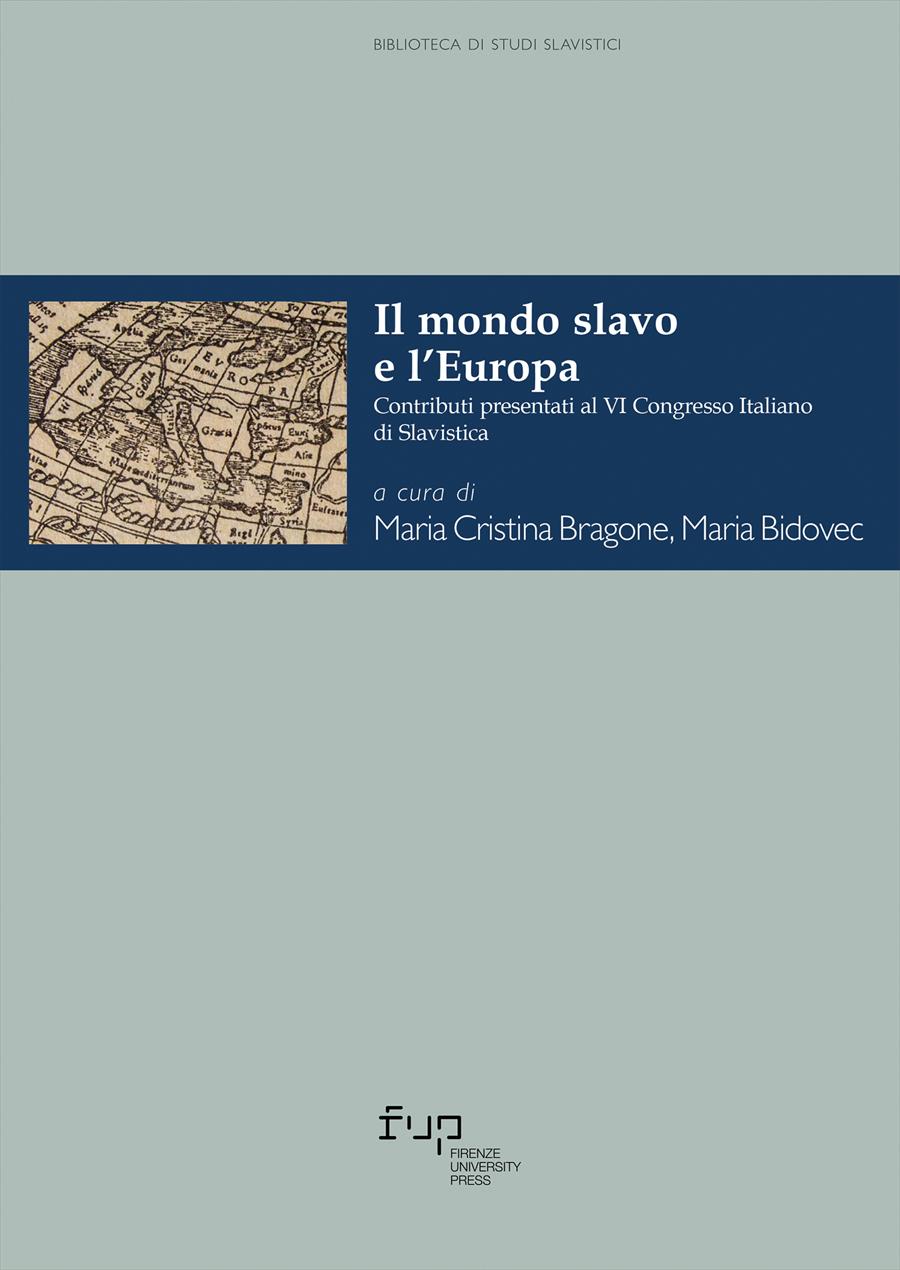- Il mondo slavo e l’Europa
- Edited by Maria Cristina Bragone, Maria Bidovec
“Kol’ dobro i kol’ krasno Christa radi umirati”. Il discorso sul martirio nell’omiletica rutena della seconda metà del Seicento e l’influsso della Controriforma
- Maria Grazia Bartolini
- © 2019 Author(s) |
- CC BY 4.0
- DOI: 10.36253/978-88-6453-910-2.04
This article investigates the rhetoric of martyrdom that developed in seventeenth-century Ukraine and specifically the discourse of Orthodox martyrdom as elaborated by Ukrainian Baroque preachers in recounting the life and death of the martyrized princes Boris and Gleb. We focus in particular on one exemplary case, that of Antonij Radyvylovs’kyj’s Slovo pervoe na sviatyx strastoterpec kniazej Borisa i Gleba (Kyiv, 1676). Tracing the contours of specific ideologies of martyrdom that arose in 17th-century Kyiv, we also address the issue of interconfessional encounters, in particular those taking place along the Orthodox-Catholic divide.
- Keywords:
- Martyrdom,
- Boris and Gleb,
- Antonij Radyvylovs’kyj,
- Lazar Baranovyč,
- 17th-century Ukrainian Literature,
University of Milan La Statale, Italy - ORCID: 0000-0001-8181-5364
- Abramovič, D.I. 1916. Žitija sviatych mučenikov Borisa i Gleba i služby im. Petrograd.
- Boyarin, D. 1999. Dying for God. Martyrdom and the Making of Christianity and Judaism. Stanford.
- Castelli, E. 2006. “The Ambivalent Legacy of Violence and Victimhood: Using Early Christian Martyrs to Think With”. Spiritus, VI.1: 1-24.
- Charipova, L. 2002. “Peter Mohyla and St Volodimer: Is There a Symbolic Link?”. The Slavonic and East European Review”, LXXX.3: 439-458.
- de Boer, W. 2001. The Turn of the Soul. Confession, Discipline and Public Order in Counter-Reformation Milan. Leiden-Boston.
- Ditchfield, S. 1995. Liturgy, Sanctity and History in Tridentine Italy. Cambridge.
- Dovha, L. 2012. Systema cinnostej v ukrajins’kij kul’turi XVII stolittja. Kiev-L’viv.
- Forrestal, A. 2005. “A Catholic Model of Martyrdom in the Post-Reformation Era: The Bishop in Seventeenth-Century France”. The Seventeenth Century, XX.2: 254-280.
- Golubev, S. 1883-1898. Kievskij mitropolit Petr Mogila i ego spodvižniki. Opyt istoričeskogo issledovanija, I-II. Kiev.
- Gregory, B. 2003. Salvation at Stake. Christian Martyrdom in Early Modern Europe. Cambridge.
- Jacobus a Varagine. 1845. Legenda aurea. Lipsiae.
- Jakovenko, N. 2005. Narys z istoriji seredn’ovičnoji ta rann’omodernoji Ukrajiny. Kyjiv.
- Koetschau, P. 1899. Origenes Werke, I. Leipzig.
- Krekoten’, V. 1983. Opovidannja Antonija Radyvylovs’koho. Z istoriji ukrajins’koji novelystyky. Kyjiv.
- Markovskij, M.N. 1984. Antonij Radivilovskij. Južno-russkij propovednik XVII v. Kiev.
- Meyendorff, P. 1985. “The Liturgical Reforms of Peter Mogila: A New Look”. St. Vladimir’s Theological Quarterly, XXIX.2: 101-114.
- Migne J.-P. (ed.). 1844-1855. Patrologiae Cursus Completus. Series Latina, 1-217. Paris.
- Moss, C.R. 2010. The Other Christs. Imitating Jesus in the Ancient Christian Ideologies of Martyrdom. Oxford.
- Novickij, I.A. 2015. Rassledovanie ubijstva knjazej Borisa i Gleba. Moskva.
- Oestreich, G. 1968. “Strukturprobleme des Absolutismus”. Vierteljahresschrift für Sozial und Wirtschaftsgeschichte, LV: 329-347.
- Plokhy, S. 2002. The Cossacks and Religion in Early Modern Ukraine. Oxford.
- Radyvylovs’kyj, A. 1676. Ohorodok Marii Bohorodicy. Kyjiv.
- Rančin, A.M. 2013. Boris i Gleb. Moskva.
- Reinhard, W. 1989. “Reformation, Counter-Reformation and the Early Modern State: a Reassessment”. Catholic Historical Review, LXXV.3: 385-403.
- Saxer, V. 1986. Bible et Hagiographie. Textes et thèmes bibliques dans les Actes des martyrs authentiques des premiers siècles. Berne-Frankfurt-New York.
- Schilling, H. (ed.). 1986. Die reformierte Konfessionalisierung in Deutschland: Das Problem der ‘Zweiten Reformation’. Gütersloh.
- Schilling, H. 1981. Konfessionskonflikt und Staatsbildung. Gütersloh.
- Schilling, H. 1992. Religion, Political Culture and the Emergence of Early Modern Society. Leiden.
- Spinei, V. 2011. Les princes martyrs Boris et Gleb: iconographie et canonization. Oxford.
- Thomson, F.J. 1993. “Peter Mogila’s Ecclesiastical Reforms and the Ukrainian Contribution to Russian Culture. A Critique of Georges Florovsky’s Theory of ‘The Pseudomorphosis of Orthodoxy’”. Slavica Gandensia, XX: 67-119.
- van Henten, J.W. 1997. The Maccabean Martyrs as Saviours of the Jewish People. A Study of 2 & 4 Maccabees. Boston-Leiden.
- Žukovs’kyi, A. 1997. Petro Mohyla i pytannja jednosty cerkov. Kiev.
Chapter Information
Chapter Title
“Kol’ dobro i kol’ krasno Christa radi umirati”. Il discorso sul martirio nell’omiletica rutena della seconda metà del Seicento e l’influsso della Controriforma
Authors
Maria Grazia Bartolini
Language
Italian
DOI
10.36253/978-88-6453-910-2.04
Peer Reviewed
Publication Year
2019
Copyright Information
© 2019 Author(s)
Content License
Metadata License
Bibliographic Information
Book Title
Il mondo slavo e l’Europa
Book Subtitle
Contributi presentati al VI Congresso Italiano di Slavistica (Torino, 28-30 settembre 2016)
Editors
Maria Cristina Bragone, Maria Bidovec
Peer Reviewed
Number of Pages
368
Publication Year
2019
Copyright Information
© 2019 Author(s)
Content License
Metadata License
Publisher Name
Firenze University Press
DOI
10.36253/978-88-6453-910-2
ISBN Print
978-88-6453-909-6
eISBN (pdf)
978-88-6453-910-2
eISBN (epub)
978-88-6453-911-9
eISBN (xml)
978-88-9273-039-7
Series Title
Biblioteca di Studi Slavistici
Series ISSN
2612-7687
Series E-ISSN
2612-7679
